


This attractive evergreen shrub features dark green leaves and so many beautiful sky blue flowers that it becomes a haze of color for 3-4 weeks in May to June. The bees are absolutely crazy for the blooms and so many visit the flowers, the entire shrub turns into a vibrating, buzzing mass. Known commonly as California lilac, this shrub is Salt spray tolerant, cold hardy to about 5ºF, and drought hardy as a rock. The key to making sure it enjoys a long life is to give it full-sun and well-drained soil. Also protect it from deer. Prune lightly every spring to maintain dense growth.

Lilac trees are among the most popular of all fragrant plants, and hummingbirds like the flowers as much as we do. Rather than enjoying the wonderful scent, however, they're after the rich nectar in the blossoms. The problem with lilacs is that they have a frustrating habit of growing taller than expected with blooms only at the top where you can barely smell them. If you don't have room for a 20 foot tree, consider planting 'Tinkerbelle lilac'. This small, sturdy shrub is hardy to well below zero,and drought tolerant as a rock. It rarely reaches 6 feet tall, and is equally at home growing in a pot as out in the garden. The tree may be small, but the flowers are every bit as fragrant. The deep pink flowers on this olfactory delight emit a rich, spicy fragrance guaranteed to please both you and your hummingbird friends.
Plant your 'Tinkerbelle' lilac in full-sun, and well-drained soil in a prominent location where you can enjoy watching the hummingbirds perform their avian stunts as they feed on the flowers.

The Pacific Northwest is one of the best areas in the world for growing primroses, and one of the showiest of them all is the Japanese primrose. These gorgeous, long flowering perennials create whorls of candelabra blooms that build on top of each other, sometimes forming as many as 6 levels of flowers on each 2 ft tall stemsin mid-spring. The flowers come in a range of white, pink and red and often bloom from early-May until July.
All they require is a moist location in bright shade. The one concern is to protect them from slugs and snails. Apply the much safer brands of slug bait containing iron phosphate such as 'Sluggo', 'Worry Free', or 'Escargo' and that should keep those midnight marauders at bay.
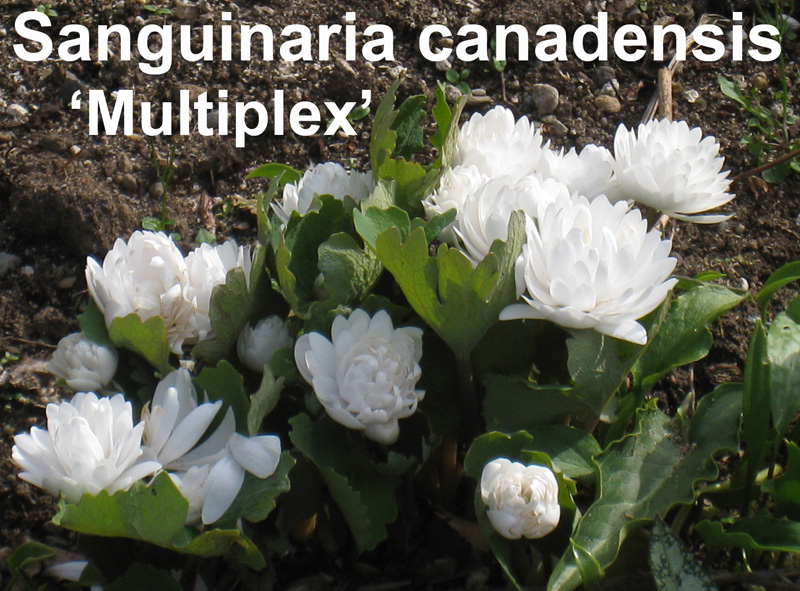
One spring ephemeral that never fails to thrill me is double flowering bloodroot. Hailing from eastern and mid-west woodlands, these native poppy relatives bloom in early spring with flowers made up of layers of satiny white paper thin petals that can only be described as drop-dead gorgeous! The blooms on the single flowering varieties are also highly attractive but each flower usually remain for only a day, while the individual blossoms on the doubles can sometimes last up to a week or more. The bluish gray, scalloped 6-12 inch round leaves are lovely in their own right, and look right at home growing amongst woodland brethren such as ferns, Trilliums and Disporums.
Given rich humusy soil, bloodroot will spread slowly to form large, much cherished colonies over time. If you find one of these gems for sale at your local nursery or at a spring plant sale, don't hesitate. They always sell out quickly.

Loropetalum chinense, commonly known as fringe flower, is an extremely attractive evergreen shrub from the woodlands of China. This relative of witch hazel (Hamamelis) features showy spider like flowers in clusters that come in red pink or white. Loropetalum is at home in the mixed border or in a pot. The horizontal branching pattern makes it easy to train as an espalier or bonsai. The species sports green leaves and white flowers; however, the leaves of many named varieties remain burgundy-red all season with flashy pink or purple blossoms. The red varieties of Loropetalum include 'Razzleberri', 'Fire Dance', 'Sizzling Pink' and my new favorite 'Jazz Hands' featuring extra large bright red flowers. No matter which variety, the plant blooms prolifically in the spring; then sporadically throughout the summer.
Grow Loropetalum in fertile, humus-rich soil in full-sun. Prune to shape and maintain size after blooms fade in spring. Don't be in a hurry to remove it even if it freezes to the ground in an extra cold winter. They almost always grow back from the roots.

Bergenia 'Bressingham Ruby' (pig squeak) is a popular ground cover featuring roundish foot-wide evergreen leaves that turn beautiful shades of red in winter followed by bright magenta flowers in spring. Famous for their ability to withstand neglect, Bergenias look their best in full-sun to bright shade and appreciate regular watering and a spring feeding of organic fertilizer. Although there are few serious pests, slugs and snails consider the leaves a gourmet treat and left untreated will leave the plants tattered and riddled with holes. Another problem is that, over time, Bergenia stems tend to grow tall and give the plant a leggy unattractive appearance. The easiest way to solve both problems is to cut the stems back about 2/3rds of the way to the ground as soon as the flowers fade. Your Bergenia will grow back beautifully with compact, bronzy new foliage.
Despite all of its qualities, I've found Bergenia to be one of the most frustrating plants I've grown. I am unable to master the skill that earned this plant its common name. I just can't make the leaves sound like a grunting pig by rubbing two of the leaves together!

Few trees have flowers that compare with Magnolias. Scientist theorize that the reason they produce such big, beautiful blooms is due to the fact that Magnolia is such an ancient genus. Most of the 210 known species appeared before bees did, and it's believed that the spectacular flowers evolved in order to attract beetles for pollination. Whatever the reason, one of my favorite Magnolias is the tulip tree (Magnolia x soulangeana). It produces such a profuse display of 6 inch wide, fragrant blooms, you can barely see the branches. There are quite a number of hybrids available, each growing to different sizes. Two with especially attractive flowers that rarely exceed 15 ft tall are 'Ann', featuring reddish-purple chalice shaped flowers, and 'Black Tulip' with deep burgundy-red cup shaped blossoms.
Magnolia x soulangeana must have well-drained soil to survive and rarely thrive in clay. They do best in full-sun sun or partial shade. Prune minimally during winter dormancy, or right after blooms fade to maintain an attractive framework. If you grow a big one over a public sidewalk, don't forget to rake up the fallen petals. They're so slippery, it's like walking over a mine-field of banana peels!

Pulsatilla vulgaris (pasque flower): If you see this Anemone relative just before it blooms, you won't be able to resist petting it. That's because it will be covered with soft down making it look almost like a puppy. Right before the leaves unfurl, the buds will open to reveal 2 inch wide bell-shaped flowers with deep golden yellow centers. The flowers are usually purple, but hybrids come in other colors including crimson red. Pulsatilla is known as wind flower because the gorgeous silky white seed heads pulse in the slightest breeze.
Grow pasque flower in well-drained soil in full sun and go light on fertilizer. Once established, Pulsatilla is quite drought tolerant and hardy to well below zero. This plant doesn't like to be divided, but can be transplanted when growth starts in spring. If you're lucky, one or two of the seeds that scatter about the garden might germinate and give you a freebie. It has only one serious pest that I know of: Deer consider it to be a gourmet treat.

Chinodoxa forbesii (glory of the snow) is a charming spring blooming bulb. One of the first to bloom, it generally begins flowering in early March, continuing into early April. This member of the asparagus family comes from high elevations in Turkey and is hardy to far below zero. The foliage grows to 6-12" tall and is topped with oodles of star-shaped attractive blue flowers with white centers. Chionodoxa is easy to grow, squirrels and deer don't bother them, and although the attractive flowers are small, they often reseed to form large, showy colonies over time.
When planting the bulbs in fall mix organic bulb food and bone meal into the soil, and water them in to remove any possible air pockets. Check at your local nursery to see if they sell potted up plants in spring. Plant a pot of them in well drained soil in a sunny location and you'll have a spectacular slowly expanding colony to grace your spring garden every year from now on.

Erythronium revolutum is a Washington native spring blooming bulb. Sometimes called fawn lily, in early spring it can often be seen in open woods, meadows, and along stream banks in coastal areas. The dark green wavy leaves are 4-10 inches long and mottled with maroon, making the foliage almost as attractive as the flowers. Each bulb produces an 8 inch stalk bearing up to 4 highly attractive, nodding pink or light purple flower with recurved petals. Erythronium revolutum prefers light shade and a moist location that never dries out completely, but I have them growing in a sunny area with good drainage resulting in a spectacular clump.
Plant the bulbs in fall about 3 inches deep. If you're lucky, you might find one potted up at your local nursery in spring.
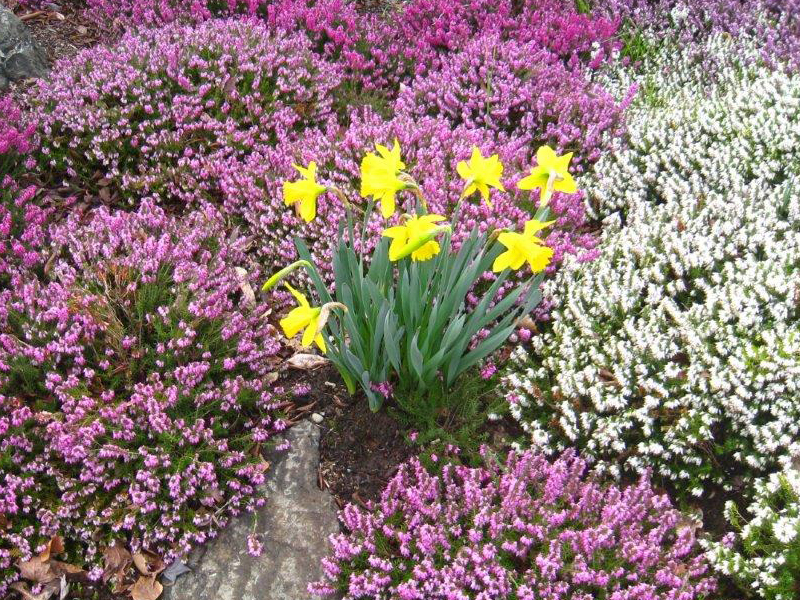
Narcissus 'Tete-a-Tete' is a spunky dwarf daffodil that features fragrant yellow petals and yellow-orange cups. About 6 inches tall, these little charmers are among the toughest of daffodils. They are hardy to well below zero, aren't touched by squirrels or deer, and although the flowers are small, they quickly naturalize to form big showy colonies.
Plant the bulbs in fall about 3" deep, mix organic bulb food and bone meal into the soil, and water them in to remove any possible air pockets. Check at your local nursery to see if they sell potted up plants in spring. Plant a pot of them in well drained soil in a sunny location and you'll have a spectacular slowly expanding colony to grace your spring garden for years to come.

Okay, it's not really a cactus, but Chamaecyparis lawsoniana 'Wissel's Saguaro' resembles one. That's because the growth habit of this contorted conifer is extremely narrow, but over time it develops arms that at first grow outward, and then turn upward, giving it a shape remarkably similar to that of a Saguaro cactus. Bluish-green, heavily congested foliage adds to the beauty of this unusual conifer. It is unknown how tall these columnar conifers will grow, but a couple of them planted 20 years ago in our garden are about 20 feet tall and 5 feet wide at the base. Give it a well-drained location in full sun and once established, water infrequently. For extra fun, give your garden a barren look by constructing a dry riverbed and adding a couple of cow skulls near where you plant your 'Wissel's Saguaro'. It'll feel like you're gardening in the Sonoran desert.

Sciadopitys verticillata is a beautiful coniferous tree that is too rarely seen in Pacific Northwest gardens. Although it's in a plant family of its own, it's known as umbrella pine because it has glossy, dark-green pine-like needles that radiate in whorls around the stems like the ribs of an umbrella. Although generally narrowly upright when young, older trees eventually develop broad, loose canopies becoming almost as wide as they are tall. In their native Japan, these slow growing trees can reach 90 feet but in the Puget Sound region, they rarely exceed 30 feet. Adding to the elegant beauty of these trees, the foliage develops a lovely bronze tint in winter. The bark on older trees becomes rich orange and brown; plus it peels in vertical strips. If you don't have room for such a large tree, Sciadopitys verticillata 'Joe Kozey' is a great choice as it stays narrow. Although it can top out anywhere from 18 to 30 feet tall, it rarely exceeds 10 feet wide. Its spirals of long, shiny green needles and narrow, spire-like form make it a great choice for a focal point or privacy screen. Hardy to about -10 degrees, Sciadopitys verticillata are best located in an open sunny location in rich, well-drained soil. Avoid planting them in heavy clay soils as the needles will yellow, thereby spoiling the appearance of what should be one of the most attractive trees in your garden.
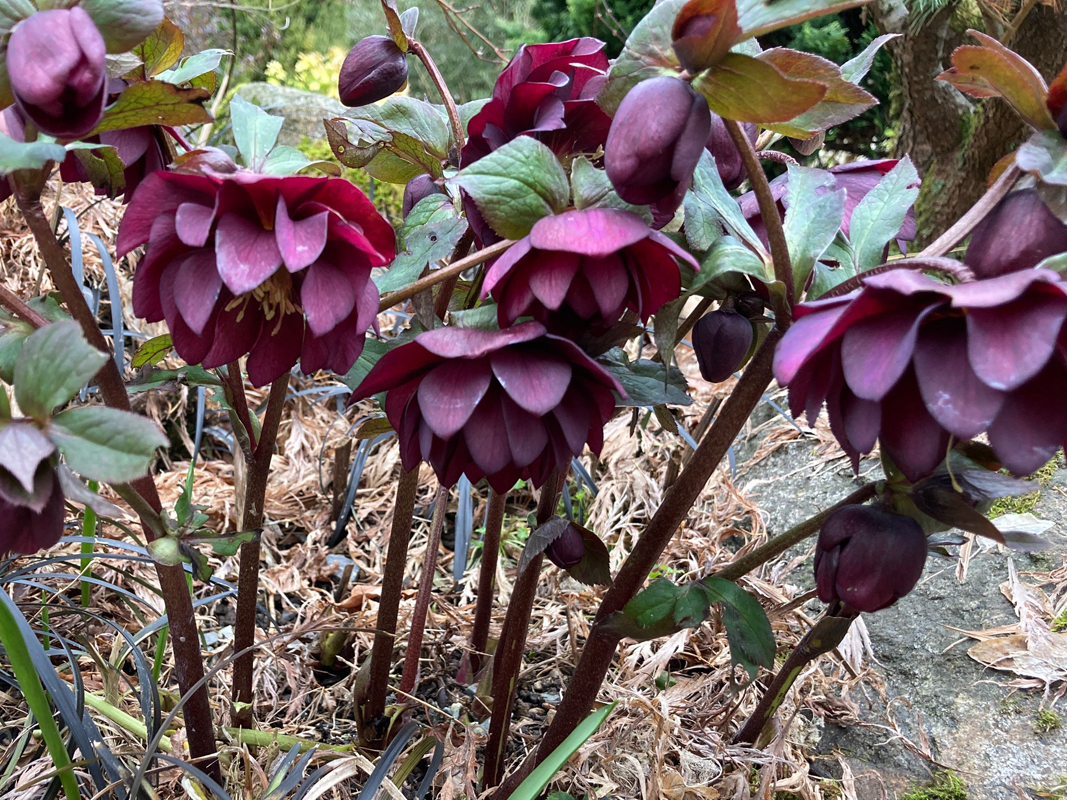
The Winter Jewels Hellebores are extremely hardy and form a mound of leathery, evergreen foliage bearing upright stems of large, saucer-shaped, double blooms in shades of midnight purple and black. Leaves emerge purple before maturing to green. This variety is long blooming: Flowers begin in winter and last well into spring. Best in part shade, place them near walkways where visitors to your garden can appreciate the spectacular flowers. Pick your site for the long run because these plants resent being disturbed or moved. Trim the old leaves to the ground in winter when the new leaves emerge.

In my opinion Cyclamen coum is one of the most delightful of winter blooming plants. Summer dormant, the foliage begins to appear in late autumn and early winter. The silver-dollar-sized leaves can be green with silver etching, or entirely pewter blue. They are quite showy and remain highly attractive well into spring. Flowers vary from white to magenta appearing as early as December with the main display in February and early March. This is one the few plants that will tolerate dry shade and does well under conifers where few other plants thrive. It will naturalize and spread slowly by seed that is dropped by ants attracted to a sweet coating. Plant this lovely winter bloomer near shady walkways where visitors can appreciate the colorful foliage and flowers.
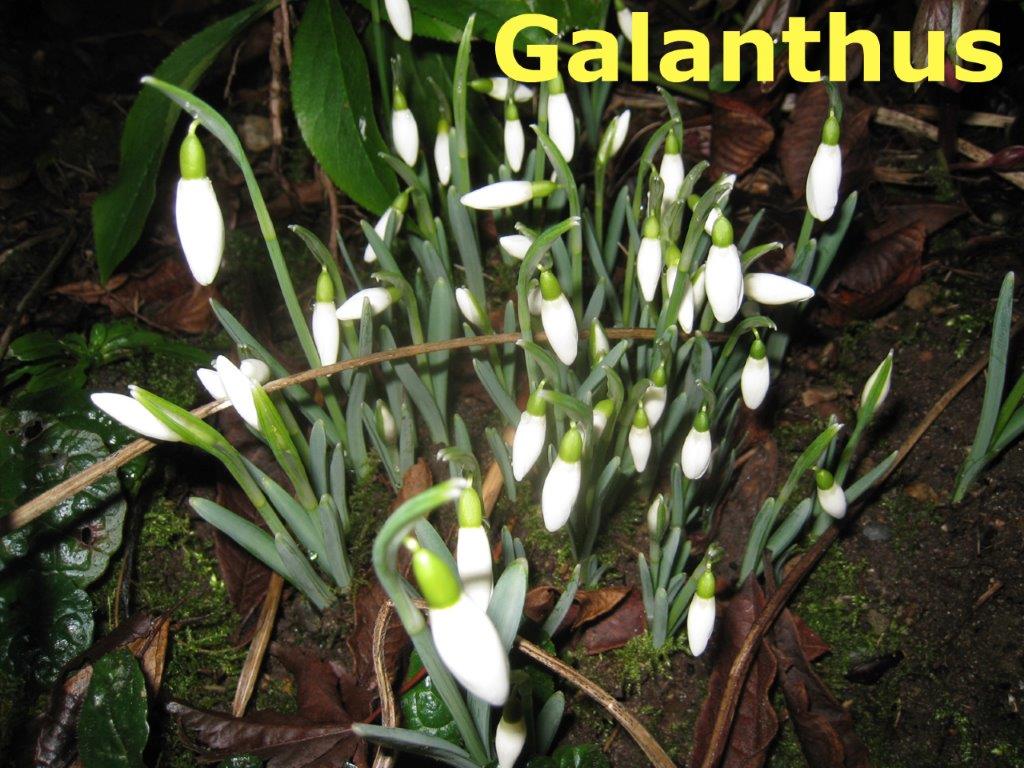
Snowdrops (Galanthus) are among the first spring bulbs to bloom, often coming up through the snow. Prized by collectors, these small but showy members of the Amaryllis family are squirrel proof, practically indestructible and form impressive sized clumps over time.
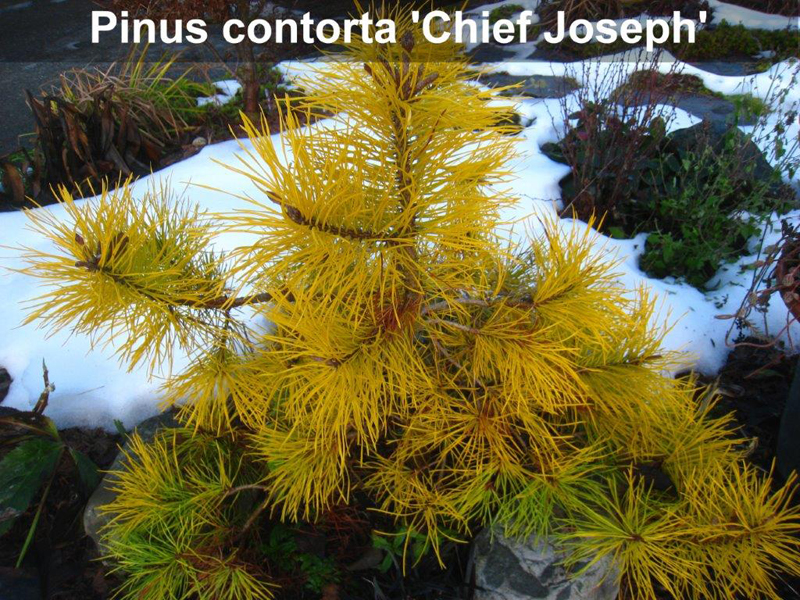
Chief Joseph lodgepole pine is a special pine with foliage that has the magical ability to change from typical pine green to shockingly brilliant golden yellow as temperatures drop in winter. This dwarf form of lodgepole pine is capable of growing to about 12 ft tall, but can easily be kept smaller with pruning. It was discovered in the Wallowa Mountains of Eastern Oregon, and named for the famous Nez Perce Indian leader Chief Joseph. The light green foliage on this winter gem turns such an electrifying mix of yellow and gold you need sunglasses to look at it.
The Chief Joseph pine is hardy to at least -40 degrees, but as is typical of pines, it requires full-sun and well-drained soil. The one negative about these beautiful trees is that they tend to hold on to old dead needles. It's not a sign of trouble, old needles are routinely sacrificed when they become unproductive, but they're unsightly and left on can ruin the spectacular winter display. Fortunately they're easy to remove. Simply rub the brown needles off and your tree will look magnificent all winter long.

If you appreciate fragrant plants, you'll love Sarcococca (sweet box). The tiny but numerous flowers on these evergreen shade lovers are so intensely fragrant that if you bring a sprig into the house, everyone will think someone is getting married in the back room.
These boxwood relatives usually begin blooming in January, and although hummingbirds lack any sense of smell, they always know when they're in bloom and visit the blossoms regularly. Sarcococca turns an ugly yellow planted in sun, but it's the perfect plant for dry shade. It comes in two forms. S. ruscifolia grows to 6 feet tall and wide and has red fruit that songbirds eat in late summer. S. hookeriana humilis is much lower growing, only reaching 1 ½ ft tall. It makes a terrific ground cover in dry shade where it spreads from underground runners. Robins and other fruit eating birds equally love the glossy blue-black fruit.

At first glance, heather (Calluna) and heath (Erica) might look alike; however, it's easy to tell them apart. Heather has feathery foliage while the leaves on heath are needle-like. Another difference is that heather blooms in summer or fall, whereas heath blooms right in the middle of winter. This might lead you to believe that only heaths would add cheery color to the winter landscape, but many heathers are stunning with foliage that turns brilliant colors in winter. My all time favorite is Calluna vulgaris 'Firefly' (firefly heather). This heather features spires of bright purple-pink flowers in late summer, but the best show happens in winter when the foliage turns flaming red putting on a spectacular show all winter long. This one grows to about 2 feet tall and 4 feet wide in many years. Other heathers with great winter color include 'Mair's Variety' with red foliage and 'Robert Chapman' cloaked in a burnished reddish-orange.
To thrive, heaths and heathers require full sun and well-drained soil. Feed with an organic Rhododendron food in March. In spring, work a light sprinkling of compost into the plant to provide a protective layer of mulch over the roots.

I love red twig dogwoods because the bare red stems glow in the winter landscape. 'Midwinter Fire is one off my favorites because it's definitely one of the showiest of them all with stems that are are glowing golden yellow at the base, while the tips are flaming red. These plants can grow to over 12 ft tall and only the new growth retains the striking color. To keep them from exceeding 5-6' tall, and to keep the twigs colorful, after the plant has been growing in a sunny location for at least 2 years, cut the entire plant to 4 inches from the ground every spring as soon as new growth begins. Kind of a nondescript green leaved shrub in the warmer months with clusters of cream flowers. 'Midwinter Fire' is drought tolerant, but can also take wet soil. Deer love them, but even when heavily chewed, they usually grow back if they're planted in a sunny location. Although these plants can live in shade, don't cut it down hard in shade. It might not grow back.

Chamaecyparis obtusa (Hinoki cypress) has long been a favorite tree of mine. These evergreen conifers are native to Japan, famous for their attractive reddish brown bark and dark green scale-like fan shaped leaves. There are a large number of compact and dwarf cultivars that have become very popular for use as small accents, specimens, hedges, screens and rock garden plants. One of the best in my opinion is 'Spiralis'. This very slow growing dwarf cultivar (1-3" per year) grows upright with a twisted trunk in an irregular, narrow conical form with branches that spiral upward and outward. It may reach 3 feeet tall over the first 10 years, eventually maturing to 12 feet tall over time. Cup shaped, twisted, dark green foliage retains good color throughout winter.

The common name of Hamamelis mollisis Chinese witch hazel. I love witch hazels because they have the appearance and stature of a tree, yet most varieties are small enough to fit easily into a typical city garden. Most have great fall color, but the best is saved for the cold season, when the bare branches are adorned with colorful spider like flowers. You might be surprised to learn that the flowers are filled with nectar making witch hazel a favorite of our overwintering Anna's hummingbirds.
There are quite a number of varieties to choose from. Chinese witch hazel is the tallest growing of the witch hazels and can reach 20 ft tall. It puts on quite a show when its bare branches are aglow with yellow, red centered blossoms. The flowers of Chinese witch hazel are also the most fragrant of any witch hazel, and add a delicious scent brought into the house in bloom for a winter bouquet. Most of the hybrids stay much smaller, rarely exceeding 15 ft tall, but the flowers are every bit as attractive.
Witch hazels are easily grown, low maintenance trees. They do best in well-drained soils in full sun or bright shade. Prune in spring after flowering to control for shape and size, and make sure to remove any root suckers from below a graft union in the process.

One of the earliest bloomers that attract hummingbirds in the winter garden is Mahonia x media 'Charity'. This relative of Oregon Grape is a hybrid of species from Asia and often begins blooming well before Christmas. It's an attractive, highly structural plant with sharp pointed; dark green foliage that resemble holly leaves. The upright, cheery yellow candelabra like flowers that top the upright branches bloom for weeks in winter and are a great nectar source for hummingbirds.
'Charity' does well in dry shade and is the perfect plant for under a high canopy of conifers. There are a lot of other varieties of Mahonia x media to choose from, and each grow to different heights. 'Charity' is a honker capable of reaching 15 ft tall and almost as wide. 'Arthur Menzies' can get to 12 ft tall, while 'Fait'h can top out at 10 feet. Slightly less tall are 'Hope' and 'Lionel Fortescue' at 6 ft, and if you're a bit squeezed for room, 'Winter Sun' rarely exceeds 4-5 ft tall. Each variety blooms at slightly different times, so the hummers will appreciate it if you plant a number of different varieties. Buy while in bloom so you can choose the variety with the color you like the best.
One important warning about these Mahonias: The leaves are really sharp. Watch your eyes when you're working around them, and take care not to back into one when you're out weeding on your hands and knees. If you do you'll find it to be a very uplifting experience!

One of the best ornamental shrubs for the winter garden has to be Callicarpa bodinieri 'Profusion', commonly known as beautyberry. This attractive arching shrub has something to offer in all seasons. The new growth in spring emerges bronze purple. In summer the leaves turn dark green, and serve as a foil for the profuse cover of lavender flowers that appear in August. In fall the leaves turn attractive shades of purple and pink. There is a reason, however, why the botanical name Callicarpa means "beautiful fruit". Profuse clusters of intense purple berries form in fall to provide a spectacular display on the bare branches in winter. Practically indestructible, these shrubs can grow to 12 feet tall and require only full to partial sun and relatively well-drained soil. They bloom and fruit on new growth, so remove wayward branches and prune for shape and size in late winter.
When beautyberry first showed up at nurseries in our area about 40 years ago, one of the selling points was that the birds didn't eat the berries, so they remained on the shrub practically all winter long. Unfortunately, the birds most likely left them alone because they weren't familiar with the shrub and therefore didn't know if the berries were edible. Evidently at some point they made an unpopular bird try one to see what would happen because eventually they figured out they not only could eat them, but found them to be a gourmet treat. Beauty berry is well worth planting anyway. You'll get to enjoy a spectacular ornamental display until the birds devour their much appreciated winter snack.

Although the name recently was changed to Hesperantha, it's still called Schizostylis at most nurseries. A member of the iris family, this plant is grown from bulb-like corms that form wide clumps over time. The nectar rich, abundant red flowers appear in clusters atop 20-inch stems that are irresistible to our Anna's hummingbirds and provide a valuable food source in fall until the winter blooming hummingbird plants begin to bloom a bit later in the season. If we experience mild weather, the blooms keep coming until well past Christmas. The grassy foliage can get a little ratty looking, but you wont' notice it due to the attractive flowers.
Hesperantha does best in moist, well-drained soil and full-sun. One last thing you should know: The common name of this bulb is 'sweet flag', but at Seattle University we called it 'the lady of the night plant'. That's because it spreads by seed and had a tendency to come up in practically every bed on the campus! Fortunately, they're easy to pull when they're young, and they're so attractive to hummingbirds, we were willing to overlook its naughty ways.

A fragrant, perennial herb to 4ft tall, with showy scarlet-red flowers. It flowers in fall and early winter just in time to keep the Anna's hummingbirds fat and happy and hanging around your garden until winter plants that feed hummingbirds begin blossoming in winter. The blooms contrast nicely against the bright, pineapple-scented yellow green foliage. Crushed leaves have the aroma and taste of pineapple, and can be used to make tea, potpourri, jams and jellies.
Pineapple sage is indigenous to Mexico and regions in Central America. It is barely hardy in the Seattle area. Ours has survived the last few winters because we use an old English gardening trick. We planted it against a sunny south wall that absorbs whatever heat there is even on the coldest winter days. At night the absorbed heat is given off by the wall, and is often enough just enough to keep a semi-tender plant from dying through the winter. If it does die, buy a new one in spring for beautiful blooms loved by hummingbirds in fall.

A small tree that produces gorgeous golden fall color is a rare find. One of the best is Acer palmatum 'Shishigashira' (Lion's mane maple). The tree has a number of rare qualities. It is the first tree in my garden to leaf out every spring and it's always among the last to drop its leaves in the fall. The tri-lobed, closely spaced, bright green leaves are crinkled giving the tree a highly unusual appearance. But the heart stopper comes in fall when the leaves turn a deep, rich gold, suffused with rose and crimson tones. The fall color is so beautiful, grown men burst into tears when they see it. After the leaves finally drop, colorful green striped bark adds a cheery glow in the winter garden. Although it's slow growing, single trunked specimens can grow to over 30 feet tall, but if you don't have room for a tall tree, multi-branched specimens rarely exceed 20 feet high. For the best fall color, plant your 'Shishigashira' in full-sun, and enjoy magnificent fall color on Thanksgiving for years to come.
Although it used to be extremely rare, 'Shishigashira' can now be found at most quality nurseries. Buy it in fall, when you can appreciate its great fall display. (Try not to get too embarrassed when you burst into tears at the nursery.)
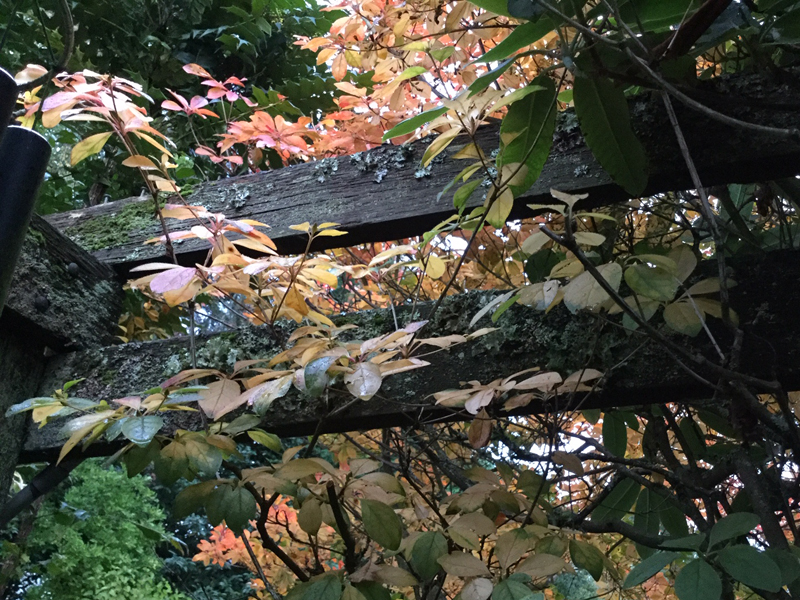
If you want to add color and contrast to an area of the garden filled with Rhododendrons and other shade-loving broad leaf evergreens, consider adding an Enkianthus to the planting. Hailing from mountain forests in Japan, these small trees are in the same plant family as Rhododendron and thrive in the same conditions: well-drained acid soil liberally amended with moisture holding compost, in partial shade or morning sun. Although they are not all that common in Northwest gardens, there are 3 species of Enkianthus generally available at local nurseries. Species vary in height, but all are extremely slow growing, and it's rare for an Enkianthus to exceed 20 feet while most varieties only reach 8 to 15 feet tall. Enkianthus possess a unique tiered branching pattern that results in a delicate looking, highly attractive upright form that contrasts beautifully with the rounder shapes on Rhododendrons and other broad leaf shade lovers. My favorite species, Enkianthus campanulatus, typically grows 6 to 8 feet tall. It features pendulous clusters of tiny, bell-shaped, nodding, creamy-yellow to whitish-pink flowers with pink striping in late spring (May/June). The bluish green leaves turn spectacular shades of red, orange, yellow and purple in the fall. Every tree colors up differently, so buy your Enkianthus in autumn to find the one with the display you find most attractive.

Fothergilla major 'Mount Airy' (Witch alder). This shade loving member of the witch hazel family is native to the southeastern U.S. These attractive small trees produce attractive honey-scented bottle-brush white flowers in spring, but the best is saved for fall when the leaves put on a dazzling display. If you're looking for a small tree that only grows to about 5 feet that puts on an unforgettable fall display, Fothergilla major 'Mount Airy' grows only to 5 feet tall and 4 feet wide. Its dark green leaves turn such glorious shades of yellow orange and scarlet, you'll have to put on your sunglasses to admire it!

Poncirus trifoliata 'Flying Dragon'. This is one wickedly beautiful plant. Although it's not a fitting shrub to plant near pets or children, Poncirus trifoliata 'Flying Dragon' is such a unique, intriguing plant, it's worth searching out a place for it in your garden. Hardy to ten below, this citrus relative features dark-green trifoliate leaves that serve as the perfect foil for an abundance of fragrant white flowers that appear in late spring. Highly ornamental, ping-pong ball sized, orange (bitter but edible) fruit follow the blossoms. In fall, the leaves turn brilliant shades of yellow and reddish-orange. It's after the leaves fall that the true magnificence of this shrub can best be appreciated as it reveals bright green twisted and contorted branches adorned with viciously curved 2-inch thorns.
'Flying Dragon' does best in full-sun and well-drained soil. Plant it near enough to pathways for visitors to appreciate its frightening winter charm, but not too close. This well-armed shrub can reach 15 feet tall and wide. If you're really brave, however, 'Flying Dragon' takes well to pruning in order to control for size.

Fritillaria imperialis is the big kahuna of spring blooming bulbs. These gorgeous plants feature a 3 foot tall stalk crowned with a 3 inch circle of unique, downward facing bell shaped flowers that come in red, orange or yellow. Old time gardeners often plant the bulbs of F. imperialis 'Corona Imperial' in with their tulips and crocus because the big, beautiful flowers smell like a fox and repel squirrels as well as rabbits, deer, and voles.
Native to Asia and the Middle East, they are hardy to -20 degrees. The bulbs should be planted 6 to 8 inches deep in fall after mixing in the amount of bulb food recommended on the label. These bulbs do best in full-sun, but the most important requirement is well-drained soil. Planted in average garden soil, they usually come up the following spring, but they hate our rainy winters and tend to rot and only come back for 2 or 3 years. Covering the bulbs right after planting with a 6 inch deep layer of sword fern fronds repels excess water, and can help keep the bulbs coming back for years. As is true of many other spring flowering bulbs, once they die back and go dormant, it's best to avoid watering the area where they are planted for the rest of summer.
Even if their spring show only lasts one season, it's worth planting at least a few of these beauties for the exotic touch they'll add to your garden.

Few if any plants in my garden garner more attention than Melianthus major 'Antonow's Blue. This 4 to 6 foot tall South African perennial boasts deeply divided, serrated leaves that bring a tropical flair to the garden. The foliage of 'Antonow's Blue', named after the late great plantsman Steve Antonow, are a luxurious, incandescent blue.
Melianthus requires a sunny, in well-drained soil. During winter, the foliage often begins to look unsightly. When that happens cut the stems to about a foot tall and fill in around them to the top of the stems with fern fronds cut from our native sword fern Polystichum munitum. The fern fronds offer insulation, but more importantly, they repel excess water allowing just enough to penetrate to keep the roots alive while keeping them from rotting in our rainy winters. In mid-March, remove the fronds and you'll see new growth just beginning to emerge at soil level. Cut the old stems back to the new growth to enable fresh foliage to grow anew.
Buy Melianthus in spring and plant these semi-tender perennials 4 to 6 inches deeper than they came out of the pot to increase hardiness and long-term survival. Even if your Melianthus 'Antonow's Blue' lasted only one season, it would be worth buying one of these spectacular plants, but I've had one growing in my garden for over 20 years, so with a bit of luck, this exotic shrub will add a touch of tropical paradise in your garden for years to come.
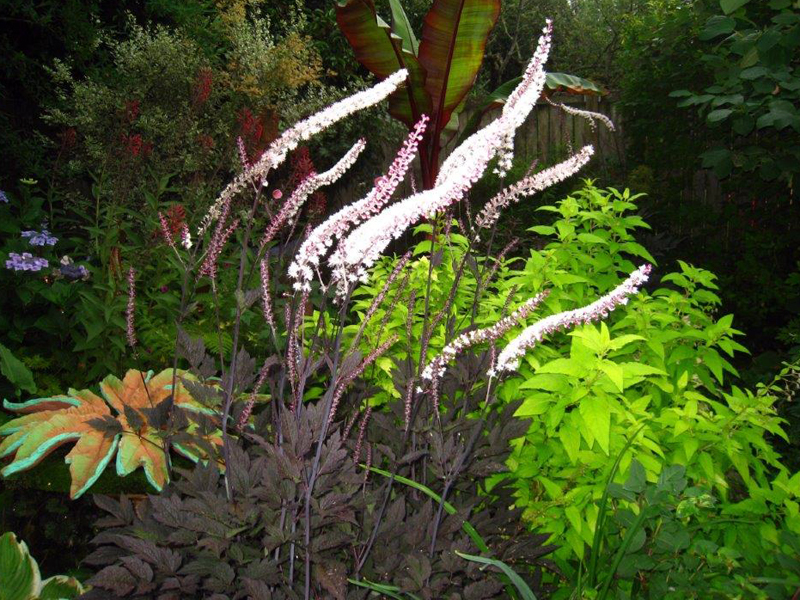
It's impossible to see this dark-leaved bugbane in a friend's garden without suffering severe plant lust. This stately perennial towers from 4 to 6 feet tall, yet it has an open airy look that adds an elegant touch to the fall garden. Its almost black, fern-like foliage contrasts spectacularly with golden-leaved or variegated shrubs and perennials. As long as it receives rich, moist, well-drained soil, and isn't in a baking hot spot, this extremely hardy (USDA Zone 4) plant can handle and color up best in full sun.
Most books recommend planting 'Brunette' in the back of the border but I prefer to plant it near the front where the sweet fragrance of the late-season, white, upright flowers can best be appreciated.
There are three outstanding dark-leaved varieties: 'Brunette', with extremely fragrant flowers is my personal favorite. Right up there are 'Hillside Black Beauty', purported to have the darkest leaves and 'Black Negligee'. Oh la la, with a name like that, who needs a description?

This ginger relative comes from the Himalayan mountains, so it's not surprising it's totally hardy in the Pacific Northwest. Hedychium coccineum 'Tara' is an upright, tropical looking plant with stems that can rise to 6 feet tall, covered with lance shaped narrow leaves. The show stopper comes in late summer when the torch like heads of orange flowers burst into bloom. Tara is easy to grow if you give it rich, well drained soil and a sunny location. A wonderful addition of color in the late summer garden.

I've long been a fan of Lagerstroemia (crape myrtle). They bloom in late summer. In fall, they put on a display of brilliant fall color. Finally, their exfoliating bark adds interest to the winter garden. The only problem I've had with these gorgeous trees in the past is that some varieties have been susceptible to powdery mildew; however there is a new group of crape myrtles, known as the 'Magic' series, that are more disease resistant and stay small.
'Lunar Magic', 'Moonlight Magic', and 'Midnight Magic' all feature dark purple foliage. 'Lunar Magic' and 'Moonlight Magic' have white flowers while 'Midnight Magic' is covered in dark pink flowers. The flowers look magnificent against the dark foliage. 'Red Magic' and 'Ruffled Red Magic' lack the dark purple foliage, but make up for it with dazzling flower displays and brilliant fall color. Buy this tree now so you can pick the flower color you like best. Then find the sunniest location in your garden for it; otherwise, you may never see the spectacular blooms again.

Fat spikes of rich red flowers are carried on 3 to 4 foot tall slender stems above large green leaves. This perennial is hardy as a rock and puts on a great show, flowering like a wild banshee from mid-summer until late fall. Persicaria amplexicaulis 'Fat Domino' loves a sunny spot, is not invasive, and best of all is rabbit resistant. The only problem with this plant is that it must have regular watering to perform at its best, but given adequate moisture, it puts on a great display practically all summer long.

This beautiful late summer bloomer is a close relative and looks very similar to the holiday gift plants that we commonly call Amaryllis. Although they both hail from South Africa, the plants sold as holiday Amaryllis are actually Hippeastrum and unlike Amaryllis belladonna, they aren't hardy outside in the Pacific Northwest. Amaryllis belladonna is hardy and thrives outdoors here as long as temperatures remain above 10 degrees. Given the right conditions, they form large colonies. These plants are commonly known as 'naked ladies' because they flower on bare stems that appear before the leaves develop. In late summer, sturdy stems rise to over 2 feet topped by clusters of 4 to 12 fragrant, large, soft pink, trumpet-like flowers. Soon after the flowers fade, strap-like leaves form 2 foot tall and wide clumps. The foliage remains until early summer before dying back completely, to remain dormant until the bare flowering stems reappear again in late summer.
In fall, the large bulbs are sometimes available at local nurseries, or online from bulb companies. Plant them 1 foot apart with the neck just peaking above the surface, in well-drained soil in a sunny location. Every year, in early-April, work organic bulb food into the soil around the clump. Amaryllis prefers not to be disturbed, but, well-established clumps can be dug up and divided. The best time to do it is in fall, right after the blooms fade. If all goes well, divisions usually begin blooming again in one to two years. Some experts recommend dividing them in summer when they are dormant. It won't harm the bulbs if you dig and divide them during their summer dormant period, but it delays flowering and chances are you won't see the spectacular flowers again for several years.

My newest favorite rare plant has to be Roscoea. These easy to grow members of the ginger family produce beautiful hooded flowers that resemble orchids. Depending on the species, the mid-summer flowers come in white, pink, blue, purple, and red. Each bloom lasts only a couple of days, but once mature, new flowers are produced in succession over a long period. My hands down favorite is Roscoea 'Family Jewels' hybrid, sporting bright magenta flowers and darkly pigmented foliage. Hardy to -20 degrees, Roscoeas form long lasting clumps in bright shade and moist well-drained soil.

Dahlia 'Karma Choc': This Dahlia is a real stunner. Its stems are as black and almost as beautiful as the velvet, chocolate-red flowers. It was bred for use as a cut flower and is quite long lasting in flower arrangements. The compact 3.5 foot tall plant produces prolifically, and the 4 inch wide flowers have a small hint of chocolate fragrance. The biggest problem I have with growing 'Karma Choc' is that every time I look at the flowers, I have an irresistible urge to run into the house and feast on dark chocolate!
Dahlias do best planted in as much sun as possible in well-drained soil. To keep them blooming non-stop, keep the root zone well mulched and water regularly. Fertilize every 6 weeks by scratching a mixture of alfalfa meal and organic flower food into the soil around the root zone, and remove spent flowers regularly!

Now and then you run into a perennial that you love so much you realize you can't possibly live without it. Lobelia tupa is such a plant. Native to Chile, these plants are hardy to well below zero. They form wide clumps of 4 foot tall sturdy upright red stems covered with green felted leaves. In late summer, it reaches a height of over 6 feet as the stems are topped with bloom spikes of tubular scarlet flowers. This plant is certain to entice the Anna's hummingbirds to take up residence in your fall garden. Grown in well-drained soil in a sunny open location, this drought-tolerant, deer-resistant perennial will loom prominent in your summer garden for years.

Agapanthus is Greek for love flower, and the beauty of the globe shaped blossoms on these lovely herbaceous perennials definitely fit the description. Known commonly as 'Lily of the Nile', Agapanthus form attractive clumps of narrow, strap-shaped leaves but the real show begins in in mid-summer, when the large showy flower clusters form at the end of tall stems. The blossoms commonly come in shades of blue or purple, but also are available in white and pink. In the old days, the only Agapanthus available had flowers in shades of powder blue, but these days new ones are showing up at nurseries and on-line with amazingly colorful flowers in varying shapes and sizes. Agapanthus 'Blue Leap' blooms in August on sturdy 4 foot stems with softball sized silvery blue flowers while Agapanthus 'Purple Cloud' has equally large heads of dark striped purple-violet blossoms. If you share my love for dark colored flowers, you won't be able to resist Agapanthus inapertus 'Graskop' and Agapanthus inapertus 'Midnight Cascade'. Both of these gorgeous plants feature unusual, drooping florets so darkly colored they almost appear to be black.
Agapanthus must have full sun and well- drained soil to thrive in our area. Although most varieties of Agapanthus are winter hardy, a few of the most interesting new varieties are hardy only to about 15 degrees, and if the cold doesn't kill them, they often rot in our rainy winters. Mulching heavily with evergreen fern fronds which adds insulation and repels excess water usually succeeds in keeping the more tender varieties alive.

Crocosmia is a great addition to the summer garden. These hardy iris relatives from South Africa are devilishly attractive perennials feature brilliantly colored flowers that are irresistible to hummingbirds and humans alike. Crocosmia blooms come in fiery shades of orange, red and yellow. The flowers appear in June, July or August depending on the variety and are produced on slender stems of 2 feet or more in length with buds that open one-by-one over a long period from the bottom up. The beautiful display usually last for at least a month and the blooms make excellent, long lasting cut flowers.
There are many varieties of Crocosmia to choose from. One of my favorites is 'Hellfire'. It grows only to about 3 feet tall, spreads slowly and sports sinfully gorgeous dark-red flowers.
As long as you give these lovely perennials plenty of sun, regular watering, and relatively well drained soil, they will bloom extensively every summer. If they become overcrowded, or you just want to start a new colony, divide them by digging and separating the corms before growth starts in early spring.
Crocosmias are generally pest free but in hot dry summers the leaves can turn an unsightly brown and dry up right as they begin to bloom. That's a sure sign your Crocosmia is infested with spider mites. Prevent this problem by spraying the leaves regularly with your hose nozzle. Use just enough force to dislodge the mites without blasting off foliage and flowers. Normally a couple of squirts a week will do the trick.

Salvia 'Hot Lips': I've yet to find a flowering plant more attractive to hummingbirds than Salvia 'Hot lips'. Those little avian acrobats are so crazy about the red and white bicolored blossoms, they actually attack me when I try to cut a few of the gazillions of flowers to show at my garden talks. This non-spreading member of the mint family has proven to be hardy in our area and, as long as it has good drainage, comes through winter unscathed. To keep your 'Hot lips' looking its best, cut the entire plant back to about 6 inches from the ground in mid-March. It will quickly grow back to form a 4 foot tall and wide shrub with small leaves and dark stems that serve as the perfect foil for the striking, bright flowers that can last well past Thanksgiving. Give them a location in full-sun where you can watch the hummers battling over every flower. Just don't get too close because if they think you might cut a branch for a bouquet, they're likely to chase you out of the garden.

'Mrs. Popple' hardy fuchsia: If you're looking for an incredibly attractive, easy to grow shrub that hummingbirds can't resist, give hardy Fuchsias a try. Unlike the tender shade loving Fuchsias that come in hanging baskets, hardy Fuchsias survive outdoors year round. These tough shrubs feature attractive colorful flowers that come in all sorts of sizes and shapes. They bloom non-stop from late-May until well after thanksgiving. The flowers hang in clusters along the tip of the branches, and are composed of the calyx, the outer section made up of sepals, (modified leaves that cover the bud) and the corolla, consisting of interior petals that form a tube.
In my opinion one of the best is definitely 'Mrs. 'Popple'. Completely hardy in the Puget Sound region, this shrub that can reach over 4 feet tall and wide is covered with inch wide flowers with bright red sepals and violet-purple tubes.
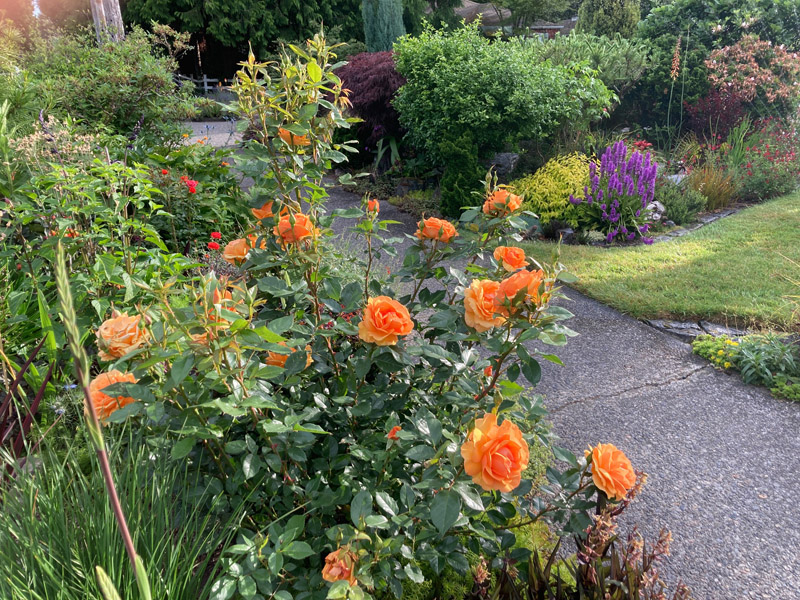
Rosa Grandiflora 'South Africa': It wasn't that long ago it was difficult to find disease resistant roses, let alone ones with gorgeous multi-petaled flowers and wonderful fragrance. Fortunately, times have changed and now a number of top rose growers are making breeding highly resistant plants with strong old rose fragrance a priority. South Africa is a prime example of a newly available rose with spectacular flowers, fragrance and disease resistance.
'South Africa' features big, golden-yellow deliciously scented flowers. The large clusters of blooms are produced prolifically all summer long, and everyone who walks by my garden can't resist commenting on how attractive the flowers are. I have yet to ever spray for disease. Best of all, they are long lasting in flower arrangements. This rose is a keeper!
By the way, for a great book on disease-resistant roses, check out Growing Roses in the Pacific Northwest by Nita-Jo Rountree.
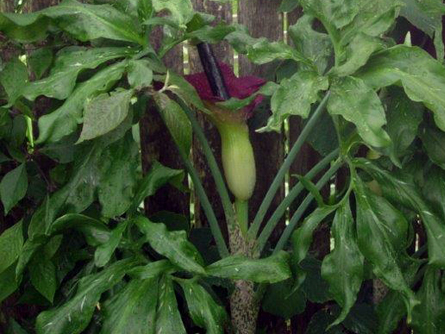
Dracunculus vulgaris (dragon or voodoo lily): This incredibly attractive perennial mysteriously shows up in Puget Sound gardens. Spread by seed dropped by birds, the first thing you'll notice is an exotic looking, green and purple mottled stem that grows to 3 or 4 feet tall with 2 or 3 heavily divided leaves. Then in mid-to-late June, an 18 inch tall, sinisterly beautiful, dark purple hooded calla lily like flower appears. It isn't the beautiful flower, however, that will get your attention! This one smells like a whole herd of cattle died in your back yard! Hardy to -20 degrees, these easy-to-grow plants thrive in well well-drained soils in full sun to part shade. Offsets, easily dug up in winter, make fun Christmas gifts. I guarantee the friends you give them to will be thinking of you when they bloom near their front door next spring!

Eucomis comosa 'Oakhurst' : Pineapple lilies (Eucomis) are unique perennials that add a beautiful, exotic touch to your garden. These lily relatives hail from South Africa. They're called pineapple lilies because the stout flower stalks crammed with colorful, star shaped blossoms are crowned with a tuft of leaves creating an appearance similar to the tropical fruit. The bloom stalks appear in mid to late summer and last for about 6 weeks. They make long lasting cut flowers and remain beautiful additions in bouquets for two or three weeks as long as you change the water every few days. The colorful foliage which emerges in spiky rosettes in mid-to-late spring is every bit as showy as the flowers. Two pineapple lilies with exceptionally colorful leaves are Eucomis comosa 'Oakhurst' and Eucomis 'Dark Star'. 'Oakhurst' sports 2 foot tall dark red spiky leaves that fade to reddish green only when the attractive burgundy spotted flowers appear 'Dark Star' is a dwarf selection that grows only to about 10 inches with narrow, dark-reddish purple leaves, creating a striking contrast with its 10 inch tall spike of sparkling burgundy-pink blooms. Another must-have dwarf is Eucomis 'Freckles'. This gem features dark green leaves, heavily spotted in purple, crowned by dark purple flowers. On the other side of the size spectrum is Eucomis pole evansii. With succulent, bright green leaves that can exceed 3 feet tall, and an equally tall flower spike packed with green and white blossoms, this monster can top out at over 6 feet tall. To add to the excitement, an even more spectacular selection, Eucomis pole evansii 'Purpurea' recently became available online. It features leaves flushed dark purple, and a burgundy flower spike highlighted with gorgeous pink-purple flowers.
Eucomis are easy to grow as long as they have well drained soil and a sunny location. Most are hardy to about zero degrees, but mulch heavily with fern fronds after they die back in fall to prevent the bulbs from rotting in cold wet winters. Be aware that some types of Eucomis can emerge late, especially in cold springs, so mark where the bulb is buried. I can tell you from experience: It's a real bummer to stick your digging spade in the soil and realize you just cut your prized Eucomis bulb in half!

Paeonia (Intersectional hybrid) x 'Bartzella: As long as there have been peonies, breeders have been frustrated because no one could figure out a way to cross a tree peony with an herbaceous one. Then in 1948, after thousands of attempts, a Japanese nurseryman named Toichi Itoh finally achieved the first successful cross. Unfortunately, Mr. Itoh died before ever seeing the hybrid he created flower. The secret of how he did it might have been lost forever, but his family shared his methods with an American breeder and over the years several of what are now referred to as 'Itoh hybrids' have been created. Itoh hybrids, however, were extremely difficult to propagate, and until about 10 years ago you could expect to pay over $1,000 for one of one of these rare beauties. Now, thanks to new propagation techniques, Itoh hybrid peonies are much more available and affordable. Every year exciting new varieties are showing up at local nurseries.
Itoh peonies feature the best traits of both parents. They resemble herbaceous peonies, forming a 3ft tall and wide dome of lacy dark green disease-resistant foliage that looks attractive all summer before turning fiery orange and red in fall. It's the incredible tree peony like, spicily scented, dinner plate sized flowers, however, that make Itoh peonies absolutely irresistible. The spectacular blossoms not only occur in late spring after most peony flowers have faded, but they're also produced on strong stems that don't require staking. Another exciting trait is that a mature Itoh peony generally bears 30 to 50 flowers that open in sequence. When one bloom fades another one takes its place, creating a long lasting florific display that can last for 3 weeks to a month. Paeonia x 'Bartzella' boasts huge bright yellow double flowers, stained red in the center, making it a dramatic show piece in my spring garden.
Plant Itoh peonies in a sunny open location in well-drained soil amended with compost. Although they are quite drought tolerant once established, water well the first season to establish a strong, healthy root system. Avoid wetting the leaves when watering to prevent Botrytis, a fungus disease that can mar the appearance of the leaves. Cut the stems down to the ground in autumn as you would herbaceous peonies. Since the flowers open over an extended period, Itoh peonies look best if you deadhead by removing the spent blossoms, using care to avoid injuring emerging flower buds in the process.
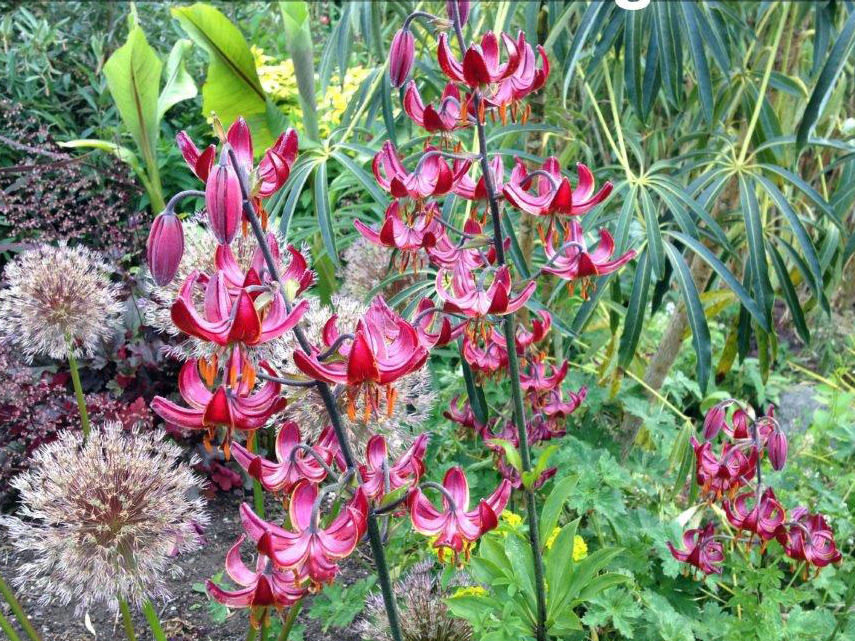
The first time I saw Lilium martagon (martagon lilies) in a friend's garden, I sought them out to plant in my garden. Hardy to at least -40 degrees, martagon lilies hail from Europe and Asia, from Portugal all the way into Mongolia. Martagon lilies aren't as showy and fragrant as many of their larger flowering cousins, but they make up for it with exotic looking, up-swept flowers that come in a wide variety of colors. Growing 4 feet tall, martagon lilies eventually form large clumps, with each stem capable of producing anywhere from 12 to 50 blossoms. Martagon lilies prefer shade, although they bloom more profusely if they receive about 4 hours of morning sun. The one drawback is that these lilies are a bit picky. They require well-drained soil and don't like too much water. Water sparingly at all times, but especially throughout summer after the flowers fade. Martagon lilies do best if you supplement their diet with calcium, an element lacking in most Puget Sound soils. Work a handful of agricultural lime into the soil around each clump every fall. Finally, if possible, plant the bulbs in autumn and choose the location carefully. These lilies resent disturbance and if you dig and move them, they'll often show their displeasure by taking a year off. In fact, when you plant them, even if you do everything perfectly, they still sometimes take over a year to come up, and it can take a couple of years before they finally begin to bloom. It's worth the wait. Martagon lilies are extremely long lived, and once they're satisfied, they'll bewitch your garden with their enchanting blooms every season for the next 80 years.

My Wisteria floribunda 'Lipstick' is in full bloom right now. Hundreds of flowers, supported by a trellis, float above our patio. Although I'm crazy about my wisteria, I have a bit of a love/hate relationship with it. It grows so fast in spring and summer, I just finish pruning it when it's time to start again. For best blooming, plant your wisteria in the sun and keep it away from your house. I once saw a wisteria that had picked up an old house off its foundation! It definitely does not need fertilizer.
You most often see the Chinese Wisteria. The blooms are shorter and it's not fragrant. Wisteria floribunda is Japanese Wisteria. The blossoms come in different colors and can be well over a foot in length; plus they are fragrant! Note that Chinese Wisteria wraps around structures in the opposite direction of Japanese Wisteria. Always let your Wisteria choose the way it grows - if you fight its natural growth habit, it'll not only rip down the structure it's on, but will tie you to it in the process!

Allium schubertii wins the prize for having one of the most bizarre, yet spectacular, flowers of any plant in the garden. Each two-foot stem is topped with a basketball-sized flower head that resembles a metallic-purple firework in mid-explosion. A. schubertii is magnificent planted en masse in an open sunny location. They usually come back two or three years in succession and then disappear. Even so, they are so cool, it's worth having to replace them every few years. Look for Allium Schubertii bulbs in fall at your local nursery and plant them in full-sun and well-drained soil. Plant the bulbs 20 inches apart, 6 inches deep and mix a handful of bone meal and a half-cup of organic bulb food under each bulb. The flowers, fresh or dried, are great in bouquets The dried flowers are long lasting and I usually leave them as a kind of garden art wherever the wind blows them in the garden. For an incredible effect, paint the dried flowers with bright red spray paint. Don't be surprised if you see people sneaking into your garden in attempt to steal the seed of what they think is a totally new type of rare flower!

A must have rarity, Podophyllum is commonly referred to as May apple. These amazing members of the barberry family (Berberidaceae) differ from their sun-loving prickly, small leaved drought tolerant Barberry shrub cousins in that they have dish size leaves, do best in bright shade and must have constantly moist soil to thrive. Although Podophyllum peltatum is an attractive May apple native to the eastern U.S, it's the Asian species that steal the show. One of the most spectacular is Podophyllum delavayi. In early April, deeply lobed, dinner plate sized leaves emerge festooned in a fuzzy kaleidoscope of burgundy-red, dark chocolate, iridescent pink and glowing purple splotches. Other showy species with fantastically colorful leaves include 'Spotty Dotty', 'Red Panda', and 'Kaleidoscope'. Without doubt, however, the most fantastic of the Podophyllums, has to be Podophyllum difforme - 'Starfish Form'. Just seeing the markings and color patterns on the foot wide leaves (as well as the price) will cause you to have an out of body experience! Hardy to about -10 degrees, once established in a woodland garden, Podophyllums form huge tropical looking clumps. They're called May apples because colorful flowers are followed by golf ball sized fruit that form under the leaves. People often ask me if you can eat the fruit. The American Natives used them to de-worm people, so unless you have worms it's probably not a good idea. Slugs and snails seem to love them as much as we do, and can ruin their appearance, so get in the habit of tossing a little slug bait around the base of the plants every few days. Admittedly, these spectacular rare and unusual plants are not inexpensive, but take it from a true plant addict: They're so amazing and make your garden so beautiful and interesting, they are worth every penny. Look for them at your local nurseries ( Swanson's Nusery offers a good selection) or you can find all of the species mentioned above online at Far Reaches Farm.
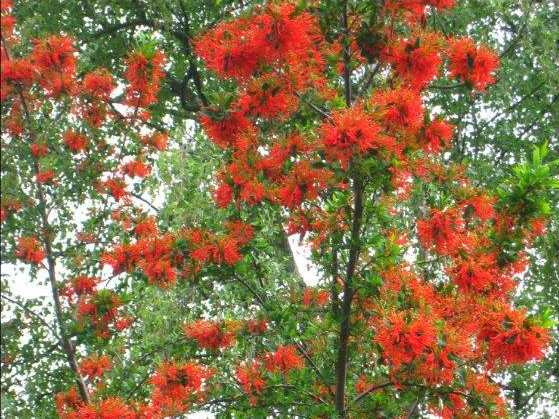
The only sight more spectacular than the profusion of brilliant, scarlet-orange tubular blooms on a Chilean fire tree (Embothrium coccineum) is the multitudes of hummingbirds that will entertain you as they do battle to claim the tree as their own private territory. Although they're hardy to about 10 degrees, these amazing May bloomers often fail during the first couple of years; therefore they have gained a reputation for being difficult to grow. Considering that the Embothrium growing in my back garden is one of the oldest in Seattle, these trees can definitely thrive if you follow a few guidelines. Avoid leaving your new tree sitting in a pot. Acquire your tree in spring (available on-line and at plant sales) and plant it in the ground as soon as possible after you get it home. It prefers lean, well-drained soil rather than a planting area well amended with compost. Although Embothriums love full-sun, the roots prefer cool shady conditions, so plant small shrubs, perennials, and groundcovers near the base of the tree to protect the roots from direct sun. Also, avoid fertilizing your Embothrium. These trees come from areas with very low levels of phosphorus and potassium; therefore adding these elements to the soil can kill the tree. Once established, these trees are extremely drought tolerant and require little summer watering. Despite their fussy nature, with a little extra care in the beginning, you'll end up with a tree that is not only drop-dead gorgeous in flower, but will also attract so many hummingbirds, you'll have to wear a hard hat to walk in the garden!

Dactylorhiza grandis (spotted Marsh orchid): A spectacular terrestrial orchid with reddish purple flower spikes that can reach over 2 feet tall. The leaves are prominently spotted and are almost as beautiful as the flowers. The clumps multiply slowly over time and flower throughout most of May and June. Best in average to moist soils in sun. If you plant other varieties of Dactylorhiza nearby, they often cross, sometimes producing stunningly attractive offspring.

Dicentra spectabilis 'Gold Heart' (gold bleeding heart) Recently renamed Lamprocapnos spectabilis 'Gold Heart': The name spectabilis means spectacular or showy in Latin, and that is exactly what the golden bleeding heart is. Golden fern like foliage lights up the shade while dangling pink and white heart shaped flowers on arching stems entice hummingbirds to visit for a nectar-filled snack. These lovely perennials often bloom just in time to attract the Rufus hummingbirds as they return from their spring migrations to Mexico. Dicentra spectabilis 'Gold Heart' prefers a shady, moist location. They're long lived and can be divided in spring every 3-4 years. At some point in mid-summer the plant will begin falling apart. Don't panic, these plants don't like summer heat and tend to go dormant in summer. Simply cut the foliage right to the ground. It will return to add beauty and attract hummingbirds to your shade garden early next spring. One warning: Avoid this plant if you have a puppy. Although many plants are poisonous, I had to remove this one when Ruby was a puppy because she was entice by the long arching branches.

Trillium kurabayashii: No woodsy garden should be without at least a few Wake robins (Trillium). Many of the more than 40 different species are native to North America. Every spring exciting species find their way on to shelves in quality nurseries. The most spectacular of the bunch has to be the Oregon native Trillium kurabayashii. Eventually forming a 2 foot tall by 3 foot wide clump, each stem on this stunningly beautiful plant is topped with a whorl of black and green deeply mottled leaves crowned with a magnificent deep-red 4 inch tall upright flower! Trilliums are amazingly easy to grow. All they need to prosper is light shade and rich, well-drained soil amended with plenty of compost. Protect from slugs, give them regular water, and the flower display will last weeks. By mid to late summer this charmer will go dormant and disappear, but don't worry: It'll be back to welcome the robins that are returning to our gardens with their spectacular display early next spring.

Ribes sanguineum (flowering current): This deciduous native shrub is hardy to about zero degrees. It usually grows from 6 to 10 feet tall. It's highly attractive to Rufous hummingbirds because it almost always blooms right when they return from their spring migration to the Pacific Northwest. Flowering currents produce hanging flower clusters with loads of nectar rich flowers irresistible to hummingbirds. The flowers on the native species are generally pink, but there are hybrids available at local nurseries with blossoms from rich red, pink, or white. They produce bluish edible but flavorless fruit. Easy to grow and drought tolerant, flowering currant can withstand poor soil. They do best in morning sun or bright shade. The only pruning necessary is to remove a wayward branch. As is true with most natives once established, Ribes sanguineum will do best with benign neglect.

Corydalis: The many varieties of Corydalis are attractive low-growing plants with ferny foliage and attractive flowers. These members of the poppy family have been extremely popular since the gentian blue flowering 'Blue Panda' was introduced in the 1980s. Now there are several varieties available that are easier to grow with fantastic flower color. Corydalis flexuosa 'China Blue' has deep blue blooms, while 'Pere David' has bright blue flowers. The easiest Corydalis to grow is 'Purple Leaf'. It has purplish-blue flowers and purple-blotched leaves. For a unique twist, try one of the red flowering varieties like Corydalis solida 'George Baker'. Watch for them at your local nursery. These Chinese natives do best in moist shade and will bloom from spring into early summer if they are given adequate moisture. Soon after the bloom fades, cut the foliage down to about 1 inch tall. The lacy foliage will grow back looking fresh and lovely.

Fatsia japonica 'Spider's Web' (spider web aralia): Now and then a truly spectacular plant finds its way into the nursery trade, and Fatsia japonica 'Spider Web' is a real winner. Like its green cousin, this incredible Fatsia will eventually grow to over 8ft tall, and features the same big, tropical looking 16 inch wide, deeply lobed fan shaped leaves. Unlike the standard variety, however, the shiny green leaves on 'Spider's Web' are adorned with heavy white web-like speckling throughout. All Fatsias require well-drained soil to flourish. They are occasionally bothered by sucking insects causing an ugly sooty mold to grow on the honeydew excreted from the bugs, but that can be easily controlled by blasting them off the back of the leaves with a powerful spray of water. Don't plant 'Spider Web', or any Fatsia for that matter, in a sunny location; the foliage will turn an ugly yellow. The beauty of this plant is that it thrives in deep shade, the perfect location for its spidery variegation to stand out in elegant fashion.

Pulmonaria: Lungworts as they are commonly called, are some of the loveliest of spring blooming perennials, and the charming flowers are a big hit with Rufous hummingbirds returning from Mexico in spring. They've been cultivated since the Middle Ages, but not always for their attractive qualities. In ancient times herbalists practiced the 'Doctrine of Signatures'. That means if you got ill, you'd be treated with an herb that looked like the part of your body that was ailing. Pulmonaria leaves resemble lungs, so if you had breathing problems you got treated with lungwort. Better to use them in the garden. Recent studies show it didn't do a bit of good! The blooms come in a wide variety of colors ranging from brick red, true pink, to deep sea blue, while the 6-10 inch long leaves are often elegantly coifed with spidery streaks, or silver spotting. Best located in woodsy shade, Pulmonaria often seeds around politely over time. The only problem with this rock hardy plant is that it's prone to infestations of powdery mildew. Prevent that by shearing the foliage to the ground soon after the flowers fade. The new leaves will grow back fresh and beautiful and remain looking great all season. Old time gardeners in this country often call Pulmonaria the brother and sister plant. That's because most varieties produce both pink and blue flowers at the same time.

One of the fun things about being a TV and radio gardener is that wholesale nurseries occasionally send me plants they hope I'll talk about on my shows. One year Skagit Gardens sent me a few really great hellebores to test in my garden. I barely got the box open before my wife Mary swooped in and grabbed the Helleborus argutifolius 'Snow Fever'. She knew a great plant when she saw one. This hybrid of the Helleborus argutifolius or Corsican Hellebore features thick evergreen leaves heavily speckled with showy white variegation that looks fantastic year round. The clumps are topped, starting in early March, with terminal clusters of creamy white flowers. The colorful leaves and flowers make this Hellebore a real standout in a shady nook in the garden. In early spring when new stems begin to grow, cut any old stems that look unsightly right to the ground to let the new attractive foliage take its place.

Cornus mas (Cornelian cherry) Cornus mas: If you've visited Southern Italy, there is a good chance that you've eaten the fruit of the dogwood commonly known as cornelian cherry. In ancient Rome cornelian cherry was grown in orchards. Today, in Rome and Tuscany, the sour but flavorful fruit is still used in place of real cherries in delicious tarts, jams and jellies. A harbinger of spring, Cornus mas is one of the first trees to bloom, bursting forth with cheery yellow flowers in early February. Cornus mas is a small tree rarely exceeding 15 - 20 ft tall and wide, and can easily be kept smaller with pruning. It is a tree for all seasons. The bright yellow flowers are followed by shiny, red inch long fruit that ripen, and if left unharvested, hang on the tree in fall when the leaves turn spectacular shades of red and yellow. In winter, an added bonus is attractive shaggy bark. Give Cornus mas full-sun and well-drained soil and it will be virtually problem free. If you are growing it for the fruit, plant more than one variety for cross-pollination. Consider planting 'Aurea' with beautiful yellow leaves, or 'Variegata' sporting irregular creamy white and green foliage. Be prepared to shout "Mama Mia" when you bite into a tart made from cornelian cherries.

Arctostaphylos 'Austin Griffiths': One of the earliest blooming manzanitas, flowering in early February. This magnificent evergreen shrub reaches about 12 feet tall, and features cherry-red bark and an open structure that allows sun to shine through. Even in cold winters it is covered with large clusters of pink, blueberry like flowers that are loved by hummingbirds. 'Austin Griffith's must have full-sun and extremely well drained soil. Once established it rarely needs supplemental watering.

Viburnum x bodnantense 'Dawn': Drought tolerant and extremely cold hardy, these tough little trees produce pink, fragrant flower clusters prized by hummers from late winter to early spring. This is a wonderful shrub for multi-season beauty. After putting on a show of pink flower clusters, thick, lustrous, green leaves cover cinnamon-colored branches. Foliage transforms to bright reds in autumn, accompanied by blue ornamental fruit.
'Pink Dawn' does well in full sun or part shade and is easily grown in average to well-drained soil. Prune out suckers and wayward sprouts to keep the shrub its most attractive.

Edgeworthia chrysantha is known as the paperbush plant. That's because the bark of some species are actually used to make Japanese yen. Growing to 8 feet tall and 4 feet wide, Edgeworthia Chrysantha has a beautiful open branched form. In spring, the tropical looking leaves emerge blueish with silvery undertones. The foliage turns glossy green in summer before morphing to rich shades of yellow in fall. It's not surprising that Edgeworthia is a close relative to Daphne. In January the clusters of lemon yellow flowers fill the air with a lovely fragrance. The long lasting flowers are filled with rich nectar, attracting our overwintering Anna's hummingbirds.
Although Edgeworthia chrysantha is hardy in zone 7, in the Puget Sound region, it is best planted in spring to give it time to become established before winter. It thrives in full-sun to light shade and appreciates well-enriched, moist soil.

If you want to drive the Anna's Hummingbirds gaga with desire, try to find a Grevillea victoriae. Covered in elegant grayish-green leaves and featuring gazillions of spectacular brilliant orange-red flowers all winter long (and other seasons too), this shrub is the queen of the winter garden. These somewhat rare shrubs often show up in spring at plant sales and occasionally at local nurseries. Planted in full-sun and well-drained soil, these Australian natives have proven to be surprisingly hardy and long-lived, often exceeding 6 feet tall and wide. If you've got room for it, I can pretty much guarantee you'll love this beautiful shrub as much as the hummingbirds do.

In my opinion, there isn't a plant on earth with a more pleasing aroma than Daphne odora. The creamy flowers open in late January and fill the air with a subtle yet irresistible aroma. When happy, this evergreen shrub usually maxes out at 4 feet tall and wide. Daphne odora 'Marginata' is coifed with glossy leaves beautifully edged with yellow. Unfortunately, Daphne odora is a temperamental shrub and the trick to growing them well is a mystery wrapped in an enigma. It's one of those odd plants that can die for no reason even if you plant it in perfect conditions, or it can flourish for years in a totally inappropriate situation with no care at all. Even if your Daphne odora is happy and thrives in given location for years, don't be surprised if you walk out the door to find it died over night for no apparent reason. Another problem is that the leaves often fall off the branches after extreme cold snaps. Don't panic if that happens. The plant will still bloom, and the leaves will grow back fresh and attractive in spring. If there's any trick to growing them, it appears they do best located in morning sun, in well-drained soil. On a positive note, 'Maejima' is a newly available variety of Daphne odora that features attractive, dark yellow leaf margins and the same fantastically fragrant pink flowers that is a bit hardier and is supposedly a bit easier to grow. If you don't mind green leaves without the variegation, Daphne odora 'Zuiko Nishiki' has beautiful flowers and just as fragrant blooms and is purported to be the toughest and most reliable of the species. Even if you murder a few, it's worth trying again in a new location. If you succeed, your nose and the hummingbirds will thank you for your efforts.
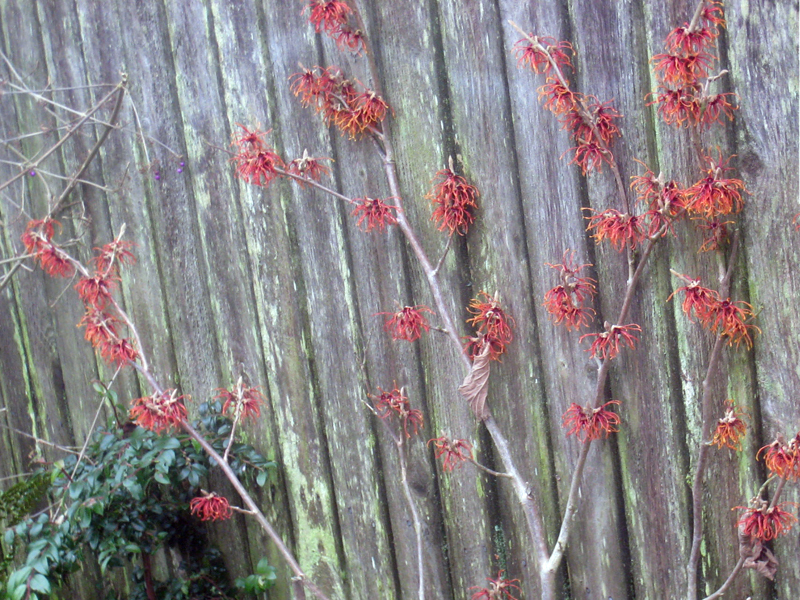
No one is sure how the spectacular, winter blooming trees in the Hamamelis genus became known as witch hazels. One explanation is that the earliest settlers to North America used branches from native Hamamelis virginiana to make divining rods and believed the tree had supernatural powers to help them find water. The real reason might be the enchanting effect created by the fragrant, spider-like flowers that cluster on bare branches in mid-winter. There are a wide variety of species and hybrid witch hazels to choose from. Flower colors include dark yellow (Arnold's Promise), red (Diane) and copper-orange (Jelena) just to mention a few. As an added attraction, the leaves of most witch hazels color up spectacularly in autumn. Books generally recommend planting witch hazel in shade, but most varieties thrive in full-sun and are drought tolerant as a rock once established. Buy them in winter while they are in bloom to get the color and fragrance you desire. But beware: If you come under their spell, you might come home with a truck load of these magical plants.
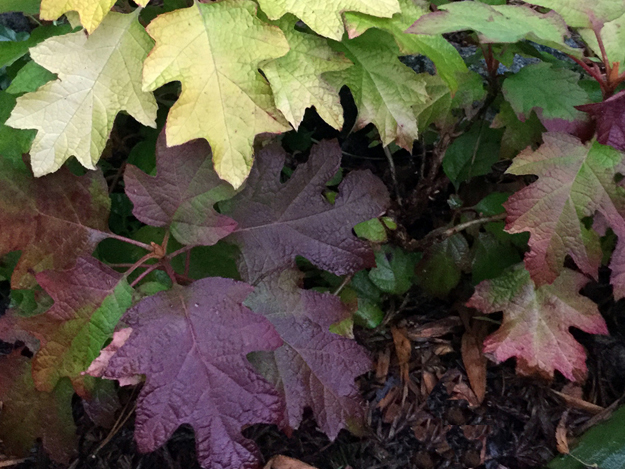
Hydrangea quercifolia 'Little Honey' is a compact spreading oak leaf Hydrangea that typically grows to 3 feet tall by about 4 feet wide. It features golden yellow, oak-shaped leaves that hold their color all summer long. In fall the majority of the leaves turn spectacular shades of crimson red, while a few remain bright yellow creating a beautiful contrast. The leaves are slow to fall making for a colorful show well into winter. The 5 inch long white flowers bloom in early summer and turn pink as they age. The only problem (other than the pricetag) is finding the right place for it. The golden leaves tend to burn if it's planted in too much direct sunshine, but they don't stay as gold if planted in too much shade. I find it does best planted where it receives morning sun and protection from direct afternoon sunshine. It thrives in rich, well-drained soil, and appreciates a summer mulch which helps retain soil moisture. As is true of all oak leaf Hydrangeas, it blooms on old wood so it's better to thin out old or crowded branches rather than cutting it back hard. Little pruning is needed but if you do, prune in early spring.
